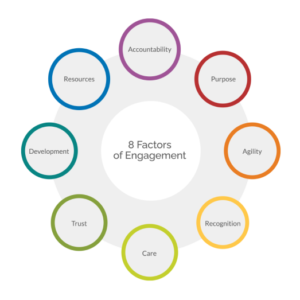The Gallup Q12 has been the industry standard for measuring employee satisfaction and engagement for over 30 years. While it is a good starting point for measuring employee engagement, it should not be considered the end all be all. One particular statement has incited controversy for the better part of a decade- “I have a best friend at work.”
Why does Gallup ask it?
Gallup’s AnnaMarie Mann says, “The simple answer is performance. Our research has repeatedly shown a concrete link between having a best friend at work, and the amount of effort employees expend in their job. For example, women who strongly agree they have a best friend at work are more than twice as likely to be engaged (63%) compared with the women who say otherwise (29%).”
So, what’s all the fuss about?
It’s important to recognize that Gallup’s statement, ” I have a best friend at work,” is fundamentally flawed for several reasons.
First, how do you measure something intangible like friendship? Without a standard definition of what the term “best friend” indicates, answers to the question are open to interpretation and give no quantifiable way to measure the health of company culture.
Second, Americans, in particular, embrace a culture that compartmentalizes their work and home lives and many survey participants push back against the terminology by stating that their “best friend doesn’t work here,” or even more emphatically, “I wouldn’t want to have my best friend work with me.”
Third, the word “best” implies that the respondent has another person in mind who is not their best friend. This sets up an expectation for the employee to compare their relationship with other people at work and determine which one is better than the other, creating friction among co-workers.
And finally, since organizations lack the ability to manufacture or control intimate personal connections, it sets leaders up against an unattainable standard that isn’t within their scope of influence. Unfortunately, companies often see these metrics as low-hanging fruit and spend resources on creating “fun” environments when research has shown other factors such as open communication and transparency are more important drivers of engagement and performance.
For Gallup’s part, they believe that the statement is phrased in such a way to garner an extreme response and thus give a more accurate reading of the health of an organization. However, since fewer than 19% of employees respond in the affirmative, it’s more likely that other factors highly influence the correlation between more engaged employees and “best friend” metrics.
Trust: a more accurate measure
Rodd Wagner, former principal at Gallup, says, “…according to our data, friendship ranks well below collaboration, teamwork, and coworker abilities for maintaining employee commitment and intensity. In fact, when all four of these issues are analyzed together relative to employees’ commitment to the company and intensity on the job, the effect of friendships is so weak it sometimes is not even statistically significant…In a head-to-head match-up between the statements “I have good friends at my current job” and “I have many strong working relationships at my job,” the latter is a much better predictor of employees’ customer focus, innovative thinking, motivation to work hard, pride in their organizations and intention to stay in their jobs.”
Here at Sicora Consulting, we’ve heard repeatedly from employees and managers that answers to the statement “I have a best friend at work?” do not provide clear and usable data for leadership. But further probing of respondents into what it means to have a best friend yields a statement that we believe is a more accurate assessment- “I have someone at work that I can completely trust.”
While Gallup’s Q12 is a survey used by thousands of companies worldwide, there are so many different factors involved with employee engagement, and there is a plethora of other tools, surveys, and research to empower your understanding and analysis of employee engagement in your organization. Ensure that the tool you are using is getting the information you need to build your organizational culture.
8 Factors of Engagement- A Balanced Holistic Approach
In 2016 after years of research, Sicora came up with the 8 Factors of Engagement, the most balanced, holistic leading indicator engagement model on the market.

It empowers employees to take command of their own engagement, which helps to lighten the burden of managers and leaders.
Then, in 2020 they took it one step further, putting the report in the hands of the employee by creating an individualized profile for everyone to receive and take action with. It is designed to help prioritize and focus on the factors that matter most and ask questions that allow the individual to go deeper into their own engagement. Ultimately preparing them to take action on their own, with their team, with their manager, and in alignment with their organization.
Team and organizational reports are also available, along with a powerful organizational impact analysis demonstrating how engagement impacts process performance, customer engagement, and the organization’s overall success.
Where’s your engagement level?
Take the 8 Factors of Engagement Assessment today to find out. It takes less than 3 minutes to complete, your profile comes to you automatically, and you can share the link (and profile) with as many “best friends” as you would like.
Click here to start the assessment.
